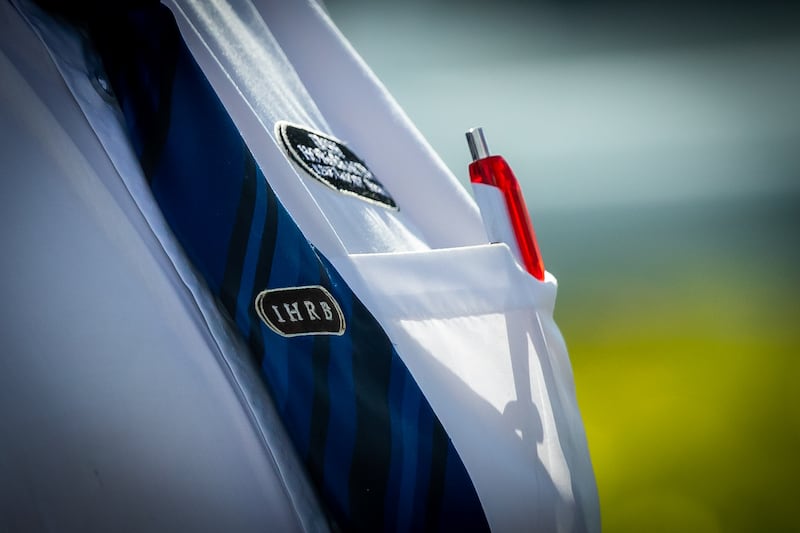That it took almost a year for a jockey to lose a major race in Britain due to breaching the whip rules is testament to the professionalism of the overwhelming majority riding there. Should someone fall foul of them again it will spell nothing but foolishness.
If there’s one positive to take from the continuing unfortunate saga of Alphonse Le Grande’s disqualification from Cesarewitch success, it is that minds have been concentrated.
Whatever one thinks of the whip rules introduced by the British Horseracing Authority last year, it is there in black and white that a rider striking a horse 10 times or more results in disqualification. Irish apprentice Jamie Powell struck Alphonse Le Grande 10 times.
Even if the horse’s connections are successful in their upcoming appeals to the BHA, it has been an unfortunate experience for Powell, a talented rider who finds himself filling the role of proving the old maxim about what’s possible being inevitable.
Honesty Policy leads hopes of a first Irish success in Ascot’s Long Walk Hurdle
Paddy Power is not so mischievous any more but there’s still a dark side to what it does
IHRB’s top investigative and security officials have left racing’s regulatory body
Cutting the Derby trip is the real way to rejuvenate Epsom Classic’s flagship status
It was bound to happen sometime that the desire to win a big pot would see a jockey in hot water. There had been just two “DQs” before this in minor races, incidents that smacked of ham-fistedness more than anything else.
But sportspeople test the boundaries to see how far they can go, especially when it matters most, and it’s Powell’s lot to have established that the BHA rules do what they say on the tin. He’s unlucky as a rare cross-channel visitor, but the deterrent has been acted upon when it counts.
There are inevitably those who continue to dismiss those rules as nonsensical. The argument goes that it’s silly to pick an arbitrary figure such as 10 as grounds for disqualification while one fewer is okay. It’s a logic that ignores how arbitrary figures of some kind are often necessary when adjudging any rules. Plenty of 18-year-olds are anything but adult, but a line must be drawn somewhere.
Or does it? The contradiction in the overall whip debate still is official insistence that its use must be curtailed while also arguing that, used correctly, it isn’t an animal welfare issue and the whip is essentially a harmless instrument.

It is entirely reasonable, theoretically at least, to argue that if racing truly believes there’s no harmful element to the modern whip, then the sport should stand over its legitimate use as an instrument for making horses go faster; just do what it says on that tin.
Take that position to its logical conclusion and there’s no need for any limits on use, a laissez-faire approach that only the most obtuse could pretend won’t lead to reputational problems farther down the road.
Instead, there’s consensus that some restraint is required, which, by definition, requires some measurement as to what’s acceptable use or not. It’s hard to see any alternative, certainly not the old “jockeys-know-best” line, or the horse “responding to pressure” bit that was a self-serving position usually employed when the stakes were highest.
There’s global acceptance now that this is no binary choice. Navigating a workable and meaningful route through such a thorny issue isn’t about finding a British solution to a British problem. Wherever there’s racing, an effective deterrent must include the option to disqualify.
What gets lost in the noise that surrounds whip controversies is how the point of tighter regulation is a focus on behavioural change.
Jockeys now are as driven to succeed as at any other time in the past when too often a win-at-all-costs approach applied if it paid off enough. Most objective observers would agree that, as a spectacle, use of the whip these days is a lot better than it used to be. Powell’s breach of the rules proved the exception that proves the rules can work.
It’s very rare for top jockeys such as Ryan Moore to pick up whip suspensions no matter where they ride in the world. You can argue that someone such as Moore is on the best horses, but equally he is under the most pressure to deliver big race results where the temptation to try to make sure with one more strike must be there. But Moore’s totting ability is flawless.
And if he can keep count of the number of strikes he delivers in the heat of competition, it surely can’t be beyond the wit of a stewarding panel to do the same.
Making a tot on the number of strikes delivered in a case you have concerns about should be a straightforward exercise. How else was the matter referred on to a whip review committee 72 hours later other than racecourse officials on the day doing just that? If by some chance it all doesn’t add up, an appeals process can take care of it just as with any other case.
Such a process really should be in place the next time a big-race outcome is impacted by the whip rules. Forewarned really should be forearmed. But that’s also a position that means jockeys really will have no excuses if they find themselves in trouble in the first place.
Something for the Weekend
Britain’s final Group One of the season, Doncaster’s Futurity, looks to have a sold favourite in WIMBLEDON HAWKEYE (2.40), who won the Royal Lodge at Newmarket on soft ground with some authority.
Cheltenham’s new season gets under way this afternoon with plenty of Irish interest over the two days. YEATS STAR (4.05) won his debut over fences in good style at Listowel and the step up to three miles tomorrow should be ideal for Gordon Elliott’s novice.

















